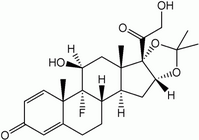Triamcinolone
Triamcinolone (trade names Kenalog®, Aristocort®, Nasacort®, Tri-Nasal®) is a synthetic corticosteroid given orally, by injection, inhalation, or as a topical cream. An injection is used in many situations where a lasting corticosteroid effect is required. This includes replacement therapy in people whose adrenal glands are not producing enough natural steroids (adrenal insufficiency) and decreasing inflammation in certain disease states. more...
Corticosteroids such as triamcinolone decrease inflammation by acting within cells to prevent the release of certain chemicals that are important in the immune system. These chemicals are normally involved in producing immune and allergic responses, resulting in inflammation. By decreasing the release of these chemicals in a particular area, inflammation is reduced. This can help control a wide number of disease states, characterised by excessive inflammation. They include severe allergic reactions, inflammation of the lungs in asthma and inflammation of the joints in arthritis. The injection can be given as a single dose to people who suffer from hayfever and do not respond to conventional therapy. This can relieve symptoms over the entire hayfever period. Triamcinolone may also be given by injection directly into a joint to relieve inflammation and pain and increase mobility of the affected joint, in conditions such as arthritis.
Triamcinolone also decreases the numbers of white blood cells circulating in the blood. This is useful for the treatment of certain types of leukaemia, where there is an abnormally large production of certain white blood cells. It is also used to treat some autoimmune diseases, which are caused by the immune system attacking the body's own tissues.
Triamcinolone is used in much higher doses than the levels of corticosteroids produced naturally by the body, and as such, the usual actions of corticosteroids become exaggerated and can be observed as side effects of this medicine.
Different triamcinolone salts are available, including acetonide, hexacetonide and diacetate.
Read more at Wikipedia.org



